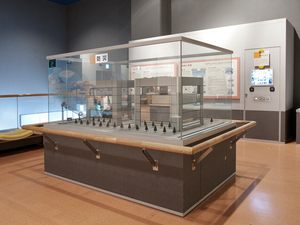Nagoya City Science Museum
TOP > Exhibition Guide > Floor Map> Urban Disasters Safety
Urban Disasters Safety



Purpose of Exhibition
In cities where many people live in large concentrated populations, there are risks particular to cities. To live in a crowded urban environment means that many people are involved when a disaster takes place. In this exhibit a variety of disasters, particularly earthquakes, are presented. It explains an idea called seismic isolation to minimize damage from an earthquake with experimental equipment and video materials.
Additional Knowledge
[Number One in the World]
The technology of seismic isolation was invented more than 100 years ago. However, there was not enough technology, and it was just an idea. In the late 1970s, a practical seismic isolation building was built in France for the first time. In 1983, there were a number built in Japan and it's said that Japan is now number one in the world for the amount of these buildings. The main reason is that Japan has a lot of earthquakes, that is, it's a "Country of Frequent Earthquakes".
[Seismic Isolation and Earthquake Resistance]
In another idea of seismic isolation to avoid transferring earthquake shaking to buildings, there is the idea of "Earthquake Resistance": that a building does not break even if it shakes violently. Earthquake resistance capacity is determined by law, and it is no problem if the building standard is certified when it is built. In fact, the law has been amended several times in the past and the standard of earthquake resistance has since become stricter. Older buildings might not meet certified present standard of earthquake resistance. Therefore, those old buildings have been reinforced with iron frames around the building to increase earthquake resistance capacity.
[Seismic Isolation Retrofit]
It is possible to make a seismic isolation structure for older buildings. It is called "Seismic Isolation Retrofit". The seismic isolation is, so to speak, "Separating" the structure of the earth and the building. With seismic isolation retrofit, the seismic isolation equipment is input into a building that is already built. For this, you dig down into the ground once, and build a temporary base aside from the building's base, then lift the building. Separating the old base parts while lifting the building, the seismic isolation equipment is installed, and the temporary base is removed.
[Main Building of Nagoya City Hall]
In Nagoya city, the main building of the Nagoya City Hall had construction work of seismic isolation retrofit over a period of about 3 years from 2007 to 2010. The original building was built in 1933, and it has the distinctive atmosphere of a Western style building with a Japanese style roof. At first glance, the building appears old, but it has the latest seismic isolation structure for protection against earthquakes.
Article by Tetsuro Ojio, curator
